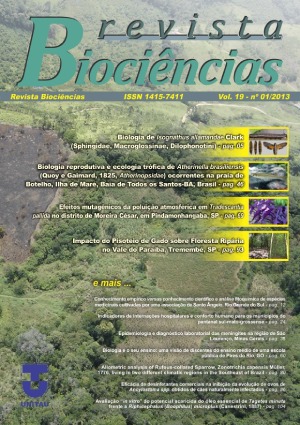Allometric analysis of Rufous-collared Sparrow, Zonotrichia capensis Müller, 1776, living in two different climatic regions in the Southeast of Brazil
Resumo
Intraspecific variations are observed in widely distributed species due to adjustments to different climate conditions. In this way, warm climate races are expected to be smaller than cold climate ones. Therefore, the main goal of this study was to compare the mass-surface ratio of Zonotrichia capensis in two different climate conditions due to altitudinal variation. Forty-four individuals were measured, being 22 specimens at 20 m of altitude in warm and humid climate and 22 specimens at 1,700m of altitude in seasonal climate of dry winter and rainy summer. Body measures used were mass, total length, wing length, mass/total length ratio, and mass/wing length ratio. Results showed that only in the winter time individuals living in high altitudes were significantly lighter and longer than those living in lower altitudes. Results were discussed as to seasonality, availability of food, and species diversity to interfere in the intraspecific morphologic variations. Keywords: altitudinal variation, climate, body mass and body surface, seasonality, Zonotrichia capensisDownloads
Não há dados estatísticos.
Métricas
Carregando Métricas ...
Downloads
Como Citar
Toledo, M. C. B., & Maia, J. S. (2013). Allometric analysis of Rufous-collared Sparrow, Zonotrichia capensis Müller, 1776, living in two different climatic regions in the Southeast of Brazil. Revista Biociências, 19(1). Recuperado de https://periodicos.unitau.br/biociencias/article/view/1736
Edição
Seção
Ciências da Natureza






